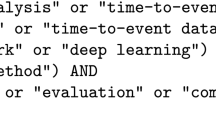Abstract
This paper presents a variant of the survival function proposed by Wong and Tsui, in which we include a component reflecting heterogeneity among individuals (frailty), together with a covariate describing the influence of certain characteristics of individuals on the response variable. Using mortality statistics for the entire Spanish population, we estimated survival functions according to the variants of the model considered, also determining life expectancies and mortality ratios at each age. The advantage of the proposed variant is that it incorporates gender differences, by including sex as a covariate. Furthermore, it reflects the intrinsic randomness of individuals. With this approach, additional parameters must be considered, but all were found to be significant.




Similar content being viewed by others
Notes
These estimated values for the scale parameters in the Spanish population are very similar to those obtained by Won-Tsui in the US population in 2010. The youth-to-adulthood component is 66.5329 for males and 66.2780 for females and the old-oldest component is 80.2327 for males and 83.8294 for females. The greater the survival of the population, the higher these values.
References
Abad, F., Vargas, M., Huete, M.D.: Estimation of quotients or death probabilities in mortality tables. International Mediterranean Congress of Mathematics, Almería (2005)
Bolker, B.: Package ‘bbmle’: tools for general maximum likelihood estimation. R package version 1.0.20. (2017)
Bongaarts, J.: Long-range trends in adult mortality: models and projection methods. Demography 42(1), 23–49 (2005)
Byrd, R., Lu, P., Nocedal, J., Zhu, C.: Algorithm 778: L-BFGS-B, FORTRAN routines for large scale bound constrained optimization. ACM T. Math. Software 23(4), 550–560 (1997)
Cayton, P.J.: Essays on non-gaussian time series analysis. PhD Thesis. Australian National University (2017)
Cohen, J.E., Bohk, C., Rau, R.: Gompertz, Makeham, and Siler models explain Taylor’s law in human mortality data. Demogr. Res. 38(1), 29–29 (2018)
Cox, D.R.: Regression models and life-tables. J. R. Stat. Soc. B 34(2), 187–220 (1972)
Denny, C.: A model of the probability of survival from birth. Math. Comput. Model. 26(6), 69–78 (1997)
Duchateau, L., Janssen, P.: The frailty model. Springer Verlag, New York (2008)
Feng, X., He, G.: Estimation of parameters of the Makeham distribution using the least squares method. Math. Comput. Simul. 77(1), 34–44 (2008)
Henderson, R., Oman, P.: Effect of frailty on marginal regression estimates in survival analysis. J. R. Stat. Soc. B 61(2), 367–379 (1999)
INE: Vital statistics: deaths. National Statistics Institute in Spain (2016)
Jiang, L., Byrd, R.H., Eskow, E., Schnabel, R.B.: A preconditioned L-BFGS algorithm with application to molecular energy minimization. Technical Report CU-CS-982–04, Department of Computer Science (2004)
Keyfitz, N., Littman, G.: Mortality in heterogeneus population. Popul. Stud. 33, 333–342 (1979)
Lancaster, T.: The economic analysis of transition data. University Press Cambridge, London (1990)
Makeham, W.M.: On the law of mortality and the construction of annuity tables. J. Inst. Actuar. 8, 301–310 (1860)
Marzolin, G., Gimenez, O.: Fitting a Gamma-Gompertz survival model to capture-recapture data collected on free-ranging animal populations. J. Open Source Softw. 3(21), 216 (2018)
Missov, T.I.: Gamma-gompertz life expectancy at birth. Demogr. Res. 28(2), 59–70 (2013)
Missov, T.I., Lenart, A., Nemeth, L., Canudas-Romo, V., Vaupel, J.W.: The Gompertz force of mortality in terms of the modal age at death. Demogr. Res. 32, 1031–1048 (2015)
Newel, C.: Methods and models in demography. John Wiley Sons, Chicago (1994)
Permadi, D.B., Burton, M., Pandit, R., Race, D., Ma, C., Mendham, D., Hardiyanto, E.B.: Socio-economic factors affecting the rate of adoption of acacia plantations by smallholders in Indonesia. Land Use Policy 76, 215–223 (2018)
Pickles, A., Crouchley, R.: Generalizations and applications of frailty models for survival and event data. Stat. Med. 3, 263–278 (1994)
Resende, M., Cardoso, V., Façanha, L.O.: Empir. Econ. 50(4), 1255–1274 (2016)
Salinas, M.: Modelos de fragilidad paramétricos Trabajo fin de máster universitario en Estadística Aplicada. Universidad de Granada, Granada (2013)
Stanley, C., Molyneux, E., Mukaka, M.: Comparison of performance of exponential, Cox proportional hazards, weibull and frailty survival models for analysis of small sample size data. J. Med. Stat. Inform. 4(1), 2–2 (2016)
Tai, T.H., Noymer, A.: Models for estimating empirical Gompertz mortality: with an application to evolution of the Gompertzian slope. Popul. Ecol. 1–14 [Published Online] (2018)
Vaupel, J., Manton, K., Stallard, E.: The impact of heterogeneity in individual frailty on the dynamics of mortality. Demography 16(3), 439–454 (1979)
Wienke, A.: Frailty models in survival analysis. Chapman & Hall, London (2010)
Wong, C.H., Tsui, A.K.: Forecasting life expectancy: evidence from a new survival function. Insurance Math. Econ. 65, 208–226 (2015)
Funding
This work was supported by the Research Group “Survival Analysis and Probability Distributions” and by the Vice-Rector’s Office for Political Science and Research, through the project “Social-Labour Statistics and Demography” [30.BB.11.1101] at the Faculty of Human Resources and Labor Relations, at the University of Granada (Spain).
Author information
Authors and Affiliations
Corresponding author
Rights and permissions
About this article
Cite this article
Huete-Morales, MD., Navarrete-Álvarez, E., Rosales-Moreno, MJ. et al. Modelling the survival function of the Spanish population by the Wong–Tsui model with the incorporation of frailty and covariates. Lett Spat Resour Sci 13, 151–163 (2020). https://doi.org/10.1007/s12076-020-00250-5
Received:
Accepted:
Published:
Issue Date:
DOI: https://doi.org/10.1007/s12076-020-00250-5




